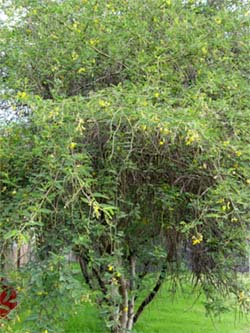BackgroundSesbania sesban (L.) Merr (Leguminosae; Papilionoideae) (Girangre in Amharic) is a perennial leguminous tree species that is widely distributed in sub-Saharan Africa. It is among the five priority species identified for use in agro-forestry systems. The species is also used in alley farming as a source of green manure and as a feed supplement to poor quality diets. Genetic improvement involving hybridisation among different accessions or species to combine elite agronomic traits is needed to develop new varieties better adapted to the needs of farmers (see Girma et al. 2002). |
 |
|
Maintenance and testing of pollen grain viability is an important aspect of plant breeding. The weather conditions and the physiological status of the parent plant can affect pollen quality. The life span of pollen of different species under natural conditions can vary from a few hours to more than a year. Pollen grain longevity is also related to the pollination mechanism, i.e. pollen grains from cross-pollinating species survive longer than pollen from self-pollinating species. Pollen grain germination rate determines the ability to deliver sperm cells to the embryo sac (female gametophytes). |
||